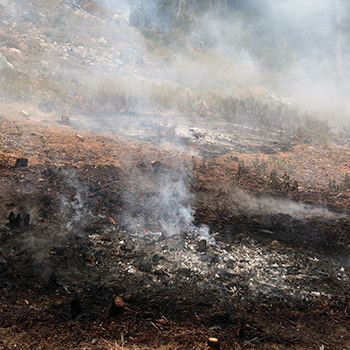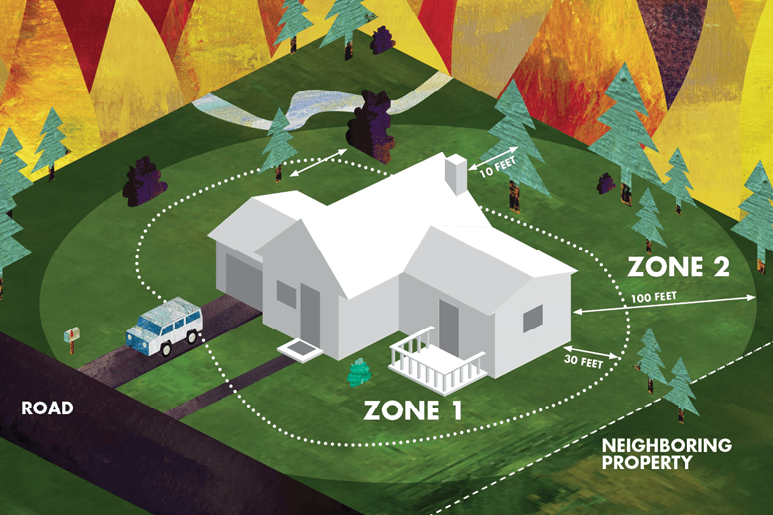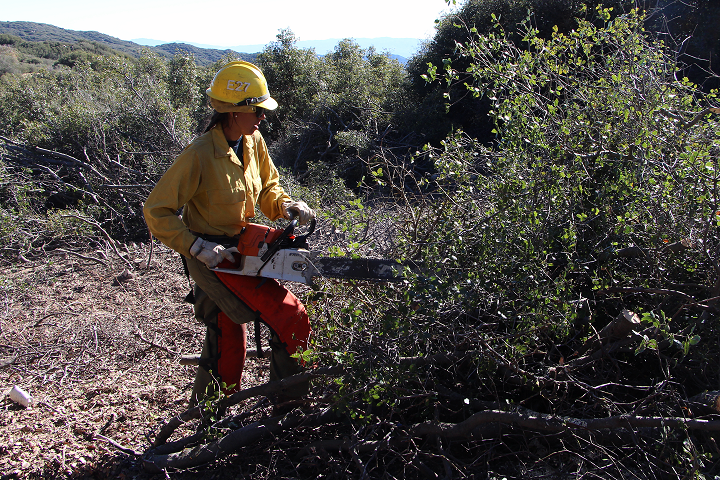Angeles Fuels Program
This video explores what makes a fire in the West unique, and demonstrates the importance and benefits of healthy fire to forest ecosystems.
The Angeles National Forest Fuels program mission is to manage fuels at the landscape scale to restore and maintain fire-resilient landscapes that are compatible with their historical fire return interval, a core goal of the Cohesive Strategy.
This is achieved through:
Prescribed Fire

Fuels smolder after a fuel reduction project in 2018 (USDA Forest Service Photo by Keila Vizcarra).
Fuel Treatments using mechanical, biological, or other non-fire methods
A variety of methods can be used to change vegetation composition, structure, and ladder fuels, which will help reduce fire hazards. These include mechanical thinning, clearing debris in forests or mowing in rangelands, among others. The opportunities include using timber markets to offset costs of mechanical fuels, using mechanical (mowing), chemical (herbicide) or biological control (grazing). The advantage of these methods is that they offer greater control over the outcome and reduce the risk of unintended consequences. The disadvantage is that these usually have a higher economic cost, but in some cases, the costs can be offset by active economic markets for the byproducts of the treatment.
Did you Know?
Under the guidance of the National Fire Plan, the use of fuel treatments to reduce the likelihood of uncharacteristic fires by the Forest Service has nearly doubled since its inception in 2001. However, the results of this national assessment suggest that the rate of fuel treatment implementation needs to be increased and that proactive wildfire management needs to be an important part of the solution. From 2008 to 2012, about 2 percent of National Forest System lands were disturbed annually by fuel treatments and wildfire.
This equates to half of the area that would have been expected to burn historically. The highest 21 wildfire hazard classes had the lowest percentage of the area treated and the highest incidence of wildfire suggesting that an alternative distribution of fuel treatment locations will likely improve program effectiveness.
 It takes the combination of defensible space and the hardening of your home to give your house the best chance of surviving a wildfire.
It takes the combination of defensible space and the hardening of your home to give your house the best chance of surviving a wildfire.
 We are preparing for wildfires while improving the overall health of the forest through fuel mitigation projects.
We are preparing for wildfires while improving the overall health of the forest through fuel mitigation projects.
 Project Activity Level (PAL) is a decision support tool designed to establish the level of industrial precaution for the following day. If your special use permit requires you to obtain PALs info, call (661) 723-2752.
Project Activity Level (PAL) is a decision support tool designed to establish the level of industrial precaution for the following day. If your special use permit requires you to obtain PALs info, call (661) 723-2752.
Alerts & Warnings
- NEW! Office & Visitor Center Updates - Need Info or Passes?
- UPDATED Closure: Small Section of the Forest Still Closed due to Bobcat Fire
- Fire Danger Increases to ‘MODERATE’ at the Angeles National Forest
- Advisory: Hiking at High Elevations
- Driving to the Forest?
- Forest Service Road Closures
- Closure: West Fork Road to recreationists on weekdays thru Dec. 1, 2024
- Closure: San Gabriel Reservoir Area thru June 30, 2024
- Planning to Camp? (Stay Limits/Dispersed Camping Restrictions) til Dec. 15, 2024


